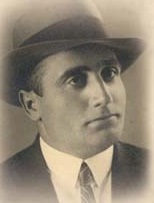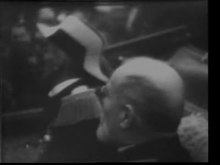Vlado Chernozemsky
Vladimir "Wlado" Georgiev Tschernosemski ( Bulgarian Владимир "Владо" Георгиев Черноземски * 19th October 1897 as Velichko Kerin-Dimitrov / Димитров Величко Керин-in Kamenica , Bulgaria ; † 9. October 1934 in Marseille , France ) was a Bulgarian revolutionary , Member of the Inner Macedonian Revolutionary Organization (IMRO) and assassin .
As a suicide bomber he shot in 1934 the dictatorial ruling Yugoslav King Alexander I and French Foreign Minister Louis Barthou .
Life
He is said to have been a member of IMRO since 1922 and to have become the personal bodyguard and chauffeur of IMRO leader Ivan Michajlow . According to Mikhailov, his full name was Vladimir Georgiev Chernozemsky (called Wlado). Therefore he was also known as Vlada (or Vlado) the chauffeur . He committed several murders in Michajlov's service. When the Serbian police murdered Mikhailov's father and brother in 1927, he decided to kill the Serbian-Yugoslav King Alexander I.

According to the report of the detective investigating the attack, Alexandre Guibbal, Chernozemsky's real name is Velitschko Kerin-Dimitrov. This is said to be by the same court in Sofia in absentia on September 7, 1928 for the murder of the communist deputy Dimo Hadschi-Dimow († September 13, 1924) under the name of Dimitrov Vladimirov and on January 5, 1932 under the name of Vladimir Georgieff Tschernozemski was sentenced to life imprisonment for the murder of IMRO member Naum Tomalewski († December 2, 1930). At the end of 1932 he had benefited from an amnesty and lived in Sofia at 75 Kozludujstrasse. According to rumors, he was then murdered on the orders of the IMRO, but was actually sent to the Croatian Ustasha organization. Kerin-Dimitrov is said to have been married twice.
Assassination attempt on Alexander I.
The IMRO leader Ivan Michajlow had connections to the Croatian Ustaše movement under Ante Pavelić , which wanted to detach Croatia from the Yugoslav kingdom created by King Alexander I. In 1929 both organizations consolidated their ties with the declaration of Sofia and decided in a joint action to assassinate the Yugoslav king during his state visit to France. For this purpose, Chernosemsky traveled to France via Switzerland with Eugen Dido Kvaternik and other Ustaše assassins .
On October 9, 1934, the king visited the port city of Marseille . He was received by the French Foreign Minister Louis Barthou . Both drove into the city center in a car convoy. Although the French police had been warned of the attack, security was very low. Thus the Chernozemsky, who was waiting at the roadside, armed with two pistols and two hand grenades , managed to break through the police line when the car passed. With the reputation Vive le roi! (Long live the King!) He stormed towards the king's limousine and fired the 10-round magazine of his Mauser C96 pistol into the inside of the car at the king, the foreign minister, General Alphonse Georges and a policeman outside the car.
The king and the foreign minister died shortly after the fact of their numerous gunshot wounds. Foissac, the driver of the car, and General Georges, who was also in the car, survived the attack. The driver was able to hold Chernozemsky by the hair and press it against the body. There, Chernosemsky, who had also been shot three times by the police, was seriously wounded by a saber blow by the French Lieutenant Colonel Piollet on horseback. Excited passers-by immediately pounced on the assassin and kicked him. Chernozemsky passed out and died on the evening of October 9, 1934 at around 10:00 p.m. in the Marseille police station of his serious injuries without having regained consciousness.
Due to the immediate braking of the driver, the car came to a stop precisely in front of a camera , so that the attack carried out by Chernozemsky became the first (almost) fully filmed attack. Two women and a police officer also died in the hail of bullets on the roadside. Furthermore, 10 passers-by were injured by ricochets .
A Czech passport in the name of Petr Kelemen was found in a Chernozemsky jacket pocket. However, the French police quickly discovered that it was a forged identity document. A tattoo was discovered on one arm : a skull with two shins crossed underneath with the inscription "Freedom or Death" in Cyrillic script and above the letters B.M.P.O., the motto and the abbreviation of IMRO. Since his identity remained unclear, the tattoo was cut out and was still in the collection of a Dr. Béroud of the Criminology Museum of Marseille. Chernozemsky was buried on October 13, 1934 in a coffin sealed several times in a cemetery in Marseilles.
Alexander I was shot in the back while Louis Barthou was shot from the front. Hence, there is speculation as to whether the king was really shot by Chernozemsky or was accidentally hit by one of his own bodyguards.
There are numerous myths surrounding the attack, and the participation of German and Italian secret services in the attack cannot be ruled out. Since Chernosemsky was known by different names, the descriptions of the background to the crime often differ. So there are different opinions whether he worked for the Croatian Ustasha or for the Bulgarian IMRO. Although this question is irrelevant, since since the declaration of Sofia (1929) both organizations planned and carried out joint actions in consultation. Because of this, Chernozemsky stayed as an IMRO liaison officer in a Ustaša training camp immediately before the attack.
Transcriptions and aliases
His name is known under various transcriptions :
- Vladimir Georgiev Chernotsemsky
- Vladimir Ghorgiev Tchernozernsky
- Vladimir "Vlado" Gheorghiev Tchernozernsky
- Vlado Chernozemski
- Vlada Chernozamsky
- Vlada Chernozemsly
- Vlado Tchernozernsky
- Vlada Georgiev
- Vlada Georgiev
respectively:
- Velichko Dimitrov-Kerin
- Veličko (Georgiev) Kerin
- Vlada Georgiyev-Kerin
- Veličko Kerin
- Velicko Dimitrov
- Dimitrov Vetitchko-Kerin
- Velichko Dimitrov-Vladimirov
In addition, he took on various aliases under which he became known:
- Dimitrov Vladimirov (sentenced to death under this name in 1928)
- Vlado (or Vlada) Makedonski (as such he was known to his fellow assassins)
- Rudolph Suk (under this code name he traveled to Marseille for the assassination attempt)
- Petr Kelemen (he had a passport with him during the assassination under this code name)
- Stoyanov
Afterlife
On the memorial stone erected in his birthplace in 2005, he is commemorated under the name Chernozemsky and next to it also under the name Dimitrov Kerin.
In Chernozemsky's place of birth Kamenitsa (near Velingrad ) and in Blagoevgrad in Bulgaria streets are named after him.
gallery
Chernozemsky in the uniform of the Croatian Ustasha (1934)
Tschernosemskis murder weapon, a German Mauser C96 with a 10-round magazine
See also
literature
- Miter Stamenov: Assassination attempt in Marseille. Vlado Chernozemsky. A life given to Macedonia . Ed .: VMRO-SMD. Sofia 1993 ( promacedonia.com - Bulgarian: Атентатът в Марсилия. Владо Черноземски. Живот, отдаден на Македони . Source work, but with a tendency to represent (per IMRO)).
- Vladislav Marjanović: The Assassination attempt in Marseille and the international fight against terrorism (1934–1938) . In: Contemporary History . Born 13. No. 6 . Vienna 1986, p. 197-204 .
- Stephen Clissold: Murder in Marseille. Chapter 3: Marseille . In: The South Slav Journal . tape 7 , no. 1-2 (23-24) , 1984, pp. 18-26 .
- Allen Roberts: The Turning Point: The Assassination of Louis Barthou and King Alexander I of Yugoslavia . St. Martin's Press, 1970.
- Vladeta Milićević : The regicide of Marseille: The crime and its background . Hohwacht-Verlag, Bad Godesberg 1959.
Web links
- Detailed analysis of the attack in the Arte film series Verschollene Filmschätze (2008) on YouTube
- Film recording of the attack by Universal Newsreel (US newsreel) on YouTube
- Interview with IMRO leader Mihalov
- Photo of Vlada the chauffeur from his forged ID
Individual evidence
- ^ A b Report by Alexandre Guibbal (Commissaire Divisionnaire Honoraire de la Police Mobile). Reprinted in: Vladeta Milićević : The regicide of Marseille. The crime and its background . Hohwacht-Verlag, Bad Godesberg 1959, p. 126 f .
- ↑ Stefan Troebst: Historical Politics and Historical “Masterpieces” in Macedonia before and after 1991 ( Memento of January 10, 2004 in the Internet Archive ) In: New Balkan Politics. No. 6, 2003: “[…] the 'suicide-assassin' from VMRO, Vlado Cernozemski, who, on orders from Mihajlov and his ethno-national VMRO, which was defined as Bulgarian, killed the Yugoslav king Alexander I Karadzordzevic and the French Minister of Foreign Affairs Louis Bareau in Marseilles in 1934. ”
- ↑ German Society for Eastern European Studies (ed.): Eastern Europe . tape 52 , no. 4 . Deutsche Verlags-Anstalt, 2002, p. 501 (“Also in 2000, members of the Macedonian Parliament took part in a memorial service for IMRO 'suicide bomber' Vlado Černozemski […]”).
- ↑ According to the Bulgarian police and confirmed by IMRO leader Iwan Michajlow in: Antonio Pitamitz: The Conspirator Rediscovered. Interview with Ivan Mihailov . In: Storia Illustrata . No. 395 , 1990, pp. 46-51 ( pavelicpapers.com [accessed June 8, 2013]).
- ↑ Information and illustration of the tattoo cut out in Dr. J. Herber: Tatouage et Politique . M. Tournus fils, Caluire, Strasbourg, Rhône 1944 (French).
| personal data | |
|---|---|
| SURNAME | Chernozemsky, Vlado |
| ALTERNATIVE NAMES | Vlada the chauffeur; Kerin-Dimitrov, Velichko; Kerin, Veličko; Dimitrov, Velicko; Dimitrov, Velicko; Vetitchko-Kerin, Dimitrov; Dimitrov-Vladimirov, Velitschko; Керин-Димитров, Величко; Chernozemski, Vlada; Chernozemsky, Vladimir Georgieff; Tchernozernsky, Vladimir Gheorghiev; Chernozemsly, Vlada; Tchernozernsky, Vlado; Chernozamsky, Vlada; Gheorghieff, Vlada; Georgiev, Vlada; Suk, Rudolph (code name); Kelemen, Peter; Stoyanov |
| BRIEF DESCRIPTION | political assassin |
| DATE OF BIRTH | October 19, 1897 |
| PLACE OF BIRTH | Kamenitsa, now part of Velingrad , Bulgaria |
| DATE OF DEATH | October 9, 1934 |
| Place of death | Marseille , France |









